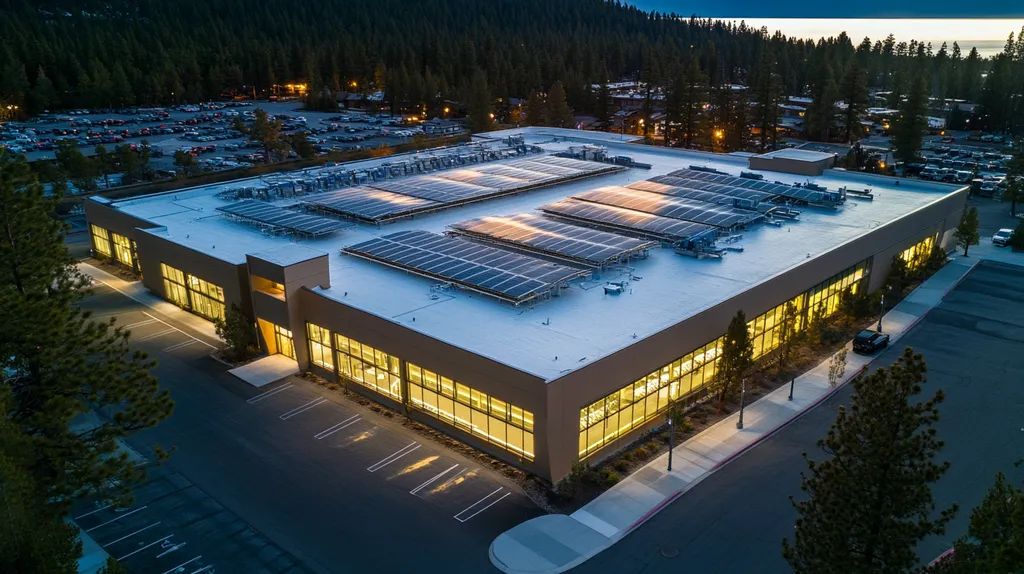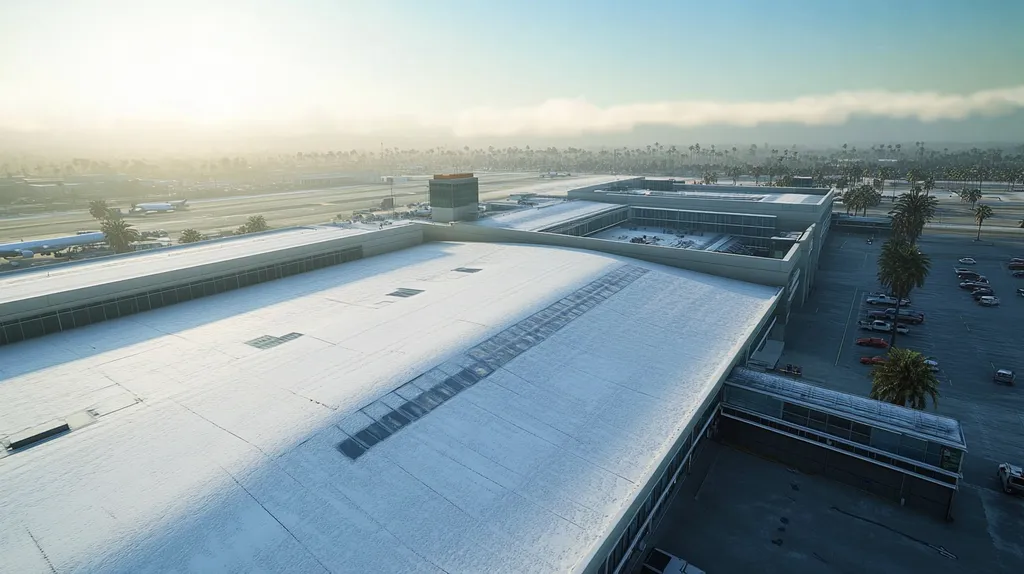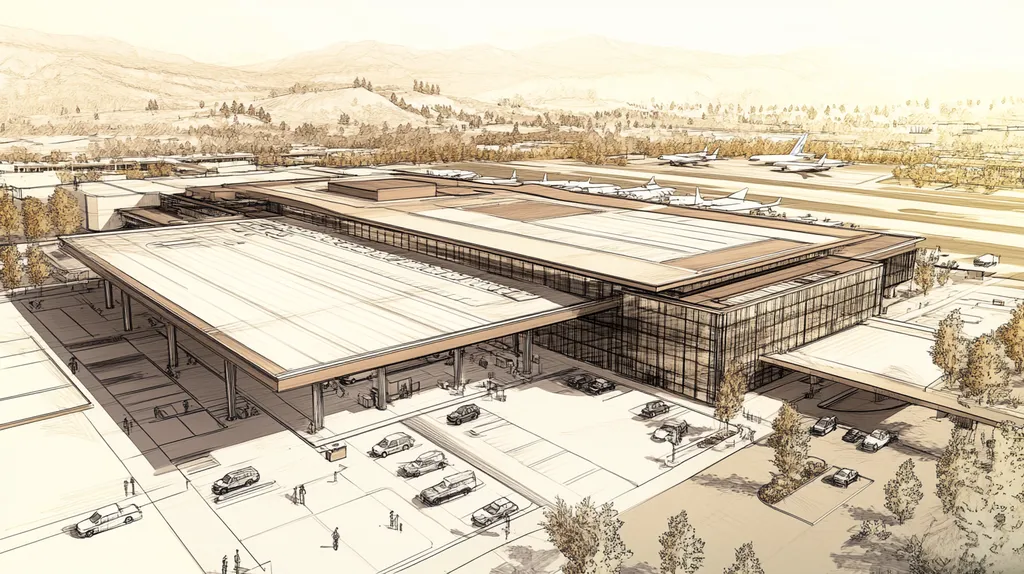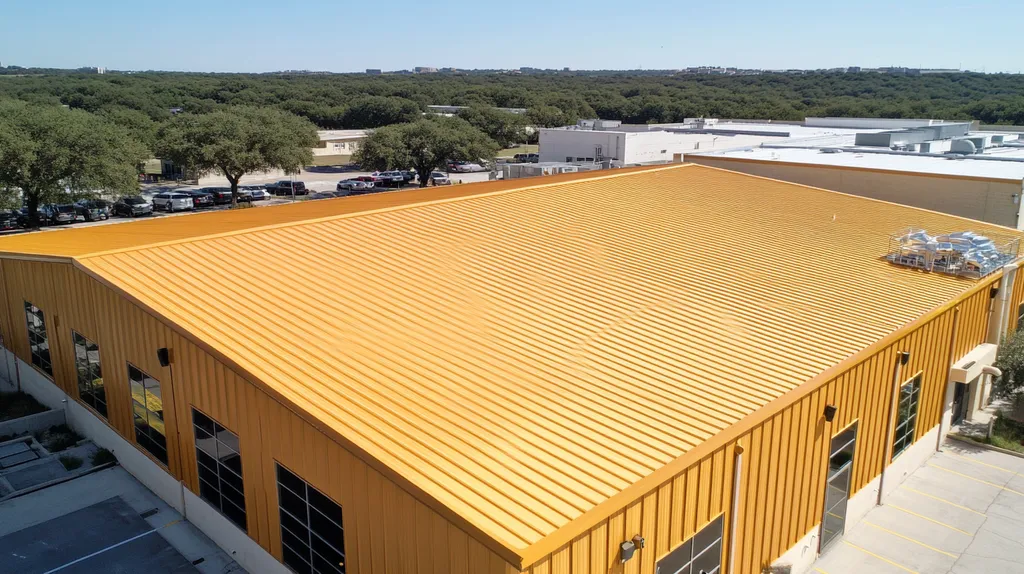When it comes to commercial roofing, conventional drainage practices are failing at an alarming rate. Industry data reveals that 40% of all roof failures stem directly from inadequate drainage systems, resulting in billions of dollars in preventable damage annually.
Despite widespread awareness of drainage issues, many property owners continue implementing outdated solutions that ignore modern challenges and technological advances. The consequences of this oversight extend far beyond simple maintenance concerns, threatening structural integrity and operational continuity.
This analysis examines why traditional prevention methods fall short and explores data-driven alternatives that can revolutionize commercial roof drainage systems.
SECTION 1: CURRENT PRACTICES
Effective roof drainage is not just important; it’s a necessity for prolonging the life of commercial roofing systems. Poor drainage can lead to significant water pooling, which is responsible for nearly half of all roof failures. With such a striking statistic, it’s essential for property owners and facility managers to understand existing drainage designs, recognize their shortcomings, and seek innovative solutions to protect their investments.
Standard Drainage System Designs
Most commercial roofs utilize a mix of internal and external drainage systems. Internal systems typically feature roof drains connected to vertical pipes that carry water away from the structure. External systems, such as scuppers and gutters, manage runoff right at the roof’s edge.
Despite their prevalence, these systems are often inadequate for various reasons. For instance, internal drains can easily become blocked with debris, resulting in unwanted water accumulation. Similarly, external systems may falter under heavy rainfall, leading to risks of overflow and leaks.
It’s vital for property owners to grasp the limitations of these common designs. Although they are widely implemented, they often lack customization for the unique needs of specific buildings. Exploring tailored drainage solutions can offer far superior protection against water-related issues.
Common Materials and Installation Methods
The effectiveness of drainage systems heavily depends on the materials and methods used in their construction. Commonly utilized materials include metal and plastic options, with metal drains (like copper and aluminum) being durable but susceptible to corrosion over time. Plastic materials, while corrosion-resistant, may struggle with extreme temperature fluctuations.
The installation process is critical as well. Many projects stick to standard materials and protocols that don’t consider each building’s unique features. Poor installation can result in inadequate sloping or improper positioning of drains, making existing drainage problems even worse.
Property owners should prioritize the selection of high-quality materials and experienced installers. Cutting corners on either can lead to significant long-term ramifications, including increased repair costs and potential safety hazards.
Routine Maintenance Protocols
Regular maintenance is often touted as the go-to solution for drainage problems. This typically includes cleaning drains and gutters, along with biannual inspections of the roofing system. Unfortunately, many property owners neglect these routine checks, allowing small issues to turn into major headaches.
Current maintenance practices frequently miss the mark, especially when it comes to serious concerns such as ponding water. Without a proactive maintenance strategy, these issues can escalate, potentially leading to extensive damage and steep repair bills.
Moreover, maintenance schedules should be tailored to address the specific requirements of each building. Generic maintenance plans often overlook unique structural features or local climate factors that can significantly affect drainage effectiveness.
SECTION 2: SYSTEMIC ISSUES
For commercial property owners and facilities managers, understanding drainage issues is not just beneficial—it’s essential to avoid substantial financial losses. The National Roofing Contractors Association highlights improper drainage as a leading cause of flat roof failures, frequently resulting in expensive repairs and considerable downtime. Recognizing the systemic flaws in existing drainage systems, from inadequate water calculation methods to frequent clogs, can help safeguard investments and enhance roof longevity.
Inadequate Water Calculation Methods
Many commercial roofs still rely on outdated practices for assessing water runoff. These calculations often fail to account for local rainfall data, as well as the roof’s specific dimensions. The outcome? Drainage systems that are undersized and ill-equipped to manage the water volume during intense rainstorms.
This miscalculation leads to dangerous pooling, which places significant stress on roofing materials. Over time, this strain can trigger roof failures, necessitating costly replacements far sooner than anticipated. Accurate water calculations are the foundation for effective drainage, yet they are often neglected during initial design phases.
Property owners must prioritize high-quality drainage designs informed by precise runoff calculations tailored to their facilities. Investing in updated methodologies can drastically improve long-term roof performance, reducing vulnerability to water-related damage. Regular reviews and recalibrations of water calculations are crucial, so partnering with roofing specialists who leverage comprehensive, data-driven assessments is a wise approach.
Insufficient Drainage for Flat Roofs
Flat roofs are inherently prone to drainage challenges due to their minimal pitch, which can obstruct natural water flow. This design issue often leads to stagnant pools of water that can compromise the roof’s integrity. Alarmingly, many flat roof designs lack adequate drainage solutions to handle heavy rainfall, posing a significant risk for property owners.
Current building codes frequently overlook the unique drainage requirements of flat roofs, a serious misstep since stagnant water can deteriorate roofing membranes and escalate maintenance costs. As a result, facilities managers often find themselves grappling with leaks and significant repair costs that could have been avoided through effective drainage planning.
Implementing enhanced drainage solutions, including tapered insulation and specialized gutter systems for flat roofs, can significantly mitigate these risks. Such mechanisms ensure water is channeled away efficiently, protecting the investment in the roof. However, without these adaptations, flat roofs remain at an unacceptably high risk of failure.
To navigate these challenges successfully, regular assessments of roof conditions and full compliance with updated building codes are vital. Engaging with experienced experts can yield advanced drainage solutions tailored to the specific profile of flat roofs.
Frequent Clogging and Blockages
Clogging is a common and pressing issue for commercial roofs, often caused by debris accumulation. Leaves, dirt, and sediment can quickly obstruct drainage systems, leading to hazardous water buildup on the roof. This scenario not only increases the chances of leaks but also poses significant risks to the roof’s structural integrity.
Many property owners fall short in performing essential preventative maintenance, leaving roofs vulnerable to these blockages. Frequently, they only resort to reactive measures after problems arise, resulting in costly emergency repairs that could have been easily avoided.
Establishing a proactive maintenance plan is crucial for successful drainage management. Regular inspections and cleanings of drainage systems can thwart debris buildup and maintain effective water flow. Facilities managers should prioritize these routine checks to stay ahead of potential drainage problems.
In addition, incorporating protective measures like mesh or screening can minimize debris entry into drainage systems. These relatively small investments can significantly extend the lifespan of the roofing system and protect against extensive damage down the line.
SECTION 3: MISSED OPPORTUNITIES
In the competitive landscape of commercial roofing, ignoring drainage issues can lead to devastating financial repercussions. Remarkably, studies reveal that nearly 30% of flat roof failures stem from inadequate drainage systems. Property owners and facility managers must acknowledge the importance of embracing innovative solutions instead of clinging to outdated methods. This section highlights the critical need to adopt advanced technologies, customize drainage systems, and consider long-term financial impacts to preserve property value and operational efficiency.
Overlooking Advanced Drainage Technologies
In the realm of commercial roofing, the adoption of advanced drainage technologies is often brushed aside. Traditional systems like internal drains and scuppers may no longer meet the demands of today’s environmental challenges. Innovative solutions, such as green roofs and permeable paving, can effectively manage water while significantly enhancing a building’s overall efficiency.
Take, for instance, a commercial property that integrates smart drainage systems. These systems can monitor water levels in real-time, allowing for proactive management and preventing overflow before it occurs. Properties investing in such state-of-the-art systems have documented significant reductions in water pooling, effectively doubling their roofs’ longevity.
Additionally, many advanced systems feature sensors that notify managers of potential drainage issues before they escalate into costly repairs. By disregarding these technological advancements, property owners not only jeopardize their roofs’ integrity but also face the likelihood of increased maintenance costs in the future.
As unpredictable weather patterns become the norm, the need to embrace modern drainage solutions grows paramount. The roofing industry must evolve beyond traditional methodologies to protect valuable investments.
Neglecting Customized Drainage Solutions
Every commercial property has distinct characteristics that greatly influence its drainage requirements. Yet, many owners mistakenly rely on one-size-fits-all solutions. This generic approach often leads to drainage systems that inadequately address the specific conditions of the site, resulting in unwanted water accumulation and potential roof degradation.
For example, facilities located in regions with heavy rainfall require bespoke drainage systems capable of handling excessive water flow. Failing to implement such customized solutions can instigate immediate damage and disrupt normal operations, leading to costly repairs.
Furthermore, custom-designed drainage systems can incorporate features that align with local building codes and climate conditions. By investing in tailored solutions, property owners can secure significant long-term benefits, extending roof lifespan and minimizing the risk of emergency repairs.
Ultimately, understanding that effective drainage is not a universal concept is essential. Customized designs enhance functionality and protect significant capital investments from future drainage-related complications.
Ignoring Long-Term Cost Implications
When it comes to drainage solutions, many property owners prioritize short-term savings over long-term financial health. This approach can have far-reaching repercussions, resulting in unresolved drainage challenges that manifest as significant costs in the future. Maintaining a robust drainage system involves more than avoiding immediate expenditures; it requires a keen awareness of future financial implications.
Inadequate investment in quality drainage systems can precipitate premature roof replacements, structural damage, and even legal liability due to tenant disputes or property damage. For instance, properties that initially skimp on drainage may find repair costs outstripping those early savings within just a few years.
Moreover, frequent water damage claims often lead to increased insurance premiums, as properties gain a reputation for drainage issues. Achieving long-term excellence in roofing mandates an upfront commitment to quality drainage solutions designed to mitigate risks and enhance property value.
In conclusion, prioritizing immediate cost savings at the expense of effective drainage solutions can lead to catastrophic outcomes. Property owners must adopt a long-range perspective that places robust drainage systems at the forefront of their roofing strategy.
SECTION 4: ROOT CAUSES
Addressing drainage issues is not merely advisable; it’s essential for the longevity of a commercial roof. Neglecting this critical aspect can lead to severe consequences, including leaks, structural deterioration, and expensive repairs. Alarmingly, the National Roofing Contractors Association reports that over 70% of roof failures are linked to drainage problems. Therefore, understanding the root causes of these issues—such as poor architectural planning, inadequate material selection, and a lack of regular inspections—is fundamental for effective roof management.
Poor Architectural Planning
The design of a roof is crucial for effective drainage. If not properly planned, roofs can easily become catchments for pooling water, which can dramatically increase the risk of leaks and structural damage. For example, roofs with low slopes often do not promote adequate water runoff, resulting in water accumulation that accelerates deterioration.
Misplaced drains can further complicate matters. When drains are not strategically positioned, water can gather far from proper outlets, leading to overload and potential system failure. It is imperative for architects to prioritize drainage considerations during the design phase to avert these types of problems.
Additionally, roofs designed without considering local rainfall patterns may struggle under heavy precipitation. Properties situated in regions known for frequent downpours need designs specifically tailored to manage excessive water effectively, avoiding disastrous outcomes.
Ultimately, poor architectural planning can hinder a roof’s functionality and impose significant financial burdens on property owners. Thoughtful design invests in the long-term durability and performance of a commercial roofing system.
Inadequate Material Selection
The materials chosen for a roofing system play a significant role in determining its drainage efficiency. Not all roofing materials can adequately channel water away, which can result in stagnant water pooling. For instance, some membranes may be more susceptible to water accumulation than others, which can drastically shorten their effective lifespan.
Selecting materials suited to withstand local weather conditions is critical. While lightweight materials may seem economically attractive, they often fail in the face of heavy rains or snow, leading to increased maintenance and repair costs over time.
Moreover, using subpar drainage components can severely compromise a roof’s effectiveness. Elements such as gutters, downspouts, and drains must be sufficiently robust to manage anticipated water loads. Using inadequate materials can lead to blockages and failures that endanger the roofing system as a whole.
In summary, investing in high-quality materials designed for efficient water drainage is pivotal for preventing future roofing issues. Property owners must collaborate closely with roofing professionals to ensure optimal material choices that bolster drainage capabilities.
Lack of Regular Inspections
Regular inspections are indispensable for identifying and addressing drainage issues before they escalate. Too often, roofs are out of sight and out of mind, leading to neglect in monitoring their condition. This oversight can result in unnoticed water pooling, which damages roofing materials over time.
Industry standards recommend biannual inspections for commercial roofs, yet many property managers overlook this critical maintenance step. A study by the Roofing Industry Committee on Weather Issues found that 40% of roofs last significantly longer when subjected to regular inspections and maintenance.
Seasonal checks are essential for identifying debris buildup that can obstruct drains and gutters. Left unchecked, this debris can cause backups and further compromise the roof’s integrity.
Ultimately, committing to regular inspections can save property owners substantial costs by preventing minor problems from escalating into major, expensive repairs. Establishing a consistent inspection schedule reinforces both the longevity and performance of commercial roofing systems.
DATA DRIVEN EVIDENCE
Failure to address drainage issues can lead to severe roof damage, resulting in hefty repair bills and lost productivity. Research shows that over 60% of commercial roof failures can be traced back to inadequate drainage systems. These alarming figures emphasize the need for property owners to reevaluate their current strategies while exploring more effective alternatives. This section highlights compelling data surrounding drainage failures, showcases successful case studies, and investigates the economic implications of poor drainage management.
Statistical Analysis of Drainage Failures
Statistical analysis reveals concerning truths about roof drainage failures. A recent study indicated that 70% of flat roofs suffer from detrimental water pooling, significantly increasing the risk of leaks and structural damage. This standing water not only accelerates wear on roofing materials but also sets the stage for more costly repairs down the line.
Additionally, the National Roofing Contractors Association highlights that approximately $1 billion is spent each year addressing repairs directly linked to inadequate drainage. Each failure is not just a roofing problem; it can disrupt business operations, leading to further financial setbacks.
These statistics underline the urgency for property owners to prioritize effective drainage solutions. By tackling these issues proactively, facilities can significantly extend roof lifespans and minimize unforeseen repair costs.
Understanding the gravity of these figures illustrates that proper drainage is not merely a maintenance concern; it’s essential for safeguarding valuable assets and ensuring the long-term viability of commercial properties.
Case Studies of Successful Alternatives
Real-world examples showcase the power of innovative drainage solutions. A notable case involved a retail facility that endured yearly leaks due to subpar drainage. After implementing a new drainage system with improved slope and refined drain placement, the building achieved zero leaks over a continuous five-year period.
Another compelling case examined a manufacturing plant that transitioned from traditional gutters to a combination of interior drains and a green roof. This strategic shift resolved drainage issues while providing additional insulation benefits, ultimately lower energy expenses.
These success stories emphasize the importance of tailoring drainage strategies to fit specific building requirements. Property owners should actively consider such customized solutions to effectively combat high-stakes problems associated with inadequate drainage.
By learning from successful case studies, property owners are encouraged to challenge conventional drainage methods and explore advanced alternatives that deliver tangible results.
Economic Impact of Inadequate Drainage
The financial consequences of overlooking drainage issues can be staggering. Facilities lacking proper drainage commonly face heightened maintenance costs that strain operational budgets. Studies reveal that these costs can be up to 35% higher annually compared to buildings equipped with effective drainage systems.
Moreover, the potential for damage-related downtime can lead to significant revenue loss. For instance, businesses can lose thousands of dollars per day due to roof failures and the necessary repairs. This highlights that addressing drainage concerns isn’t just about maintenance; it’s also a critical financial strategy.
Furthermore, taking proactive measures with drainage systems enhances property value, making them more appealing to prospective buyers or tenants. Properties that demonstrate consistent maintenance practices are often perceived as reliable investments.
In conclusion, the economic impact of inadequate drainage systems is profound. By investing in effective drainage solutions, property owners will not only protect their roofs but also secure their financial future.
SECTION 6: ALTERNATIVE SOLUTIONS
In the realm of commercial roofing, addressing drainage issues is not merely a precaution; it’s vital for safeguarding property integrity. Stagnant water can lead to leaks, structural deterioration, and hefty repair bills. Alarmingly, statistics reveal that roof drainage failures contribute to 30% of commercial roof challenges, underscoring the necessity for effective solutions. This section delves into innovative alternatives poised to transition traditional drainage systems into powerful defenses against water damage.
Implementing Siphonic Drainage Systems
Siphonic drainage systems emerge as a groundbreaking solution for tackling heavy rainfall and water buildup. Unlike conventional gravity systems, these systems utilize vacuum pressure to efficiently funnel water away from roofs. This innovative design significantly reduces the number of required roof drains, leading to lower installation and maintenance costs.
The compact nature of siphonic systems permits slimmer roof designs, which can be transformative for space-constrained structures. By swiftly redirecting water, these systems effectively minimize the risk of ponding, a notorious contributor to roof failure.
Moreover, siphonic drainage enhances the longevity of roofing materials by preventing the corrosion and wear that result from prolonged water exposure. As water is efficiently drained, property owners can enjoy cost savings on repairs and early replacements.
In addition to performance improvements, adopting siphonic systems aligns with sustainability goals. The reduction in water pooling not only protects the roof but also lessens the environmental impact, making it a win-win for stakeholders and the planet alike.
Using Durable and Low-Maintenance Materials
The choice of materials for drainage components is critical to maintaining long-term roof integrity. Opting for durable, low-maintenance options such as PVC and HDPE offers exceptional resistance to corrosion and chemicals. Investing in these materials reduces the frequency of repairs, ultimately saving property owners money.
Take reinforced membranes, for instance, which can endure harsh weather while seamlessly integrating with existing drainage systems. These enhancements not only minimize maintenance efforts for property managers but also contribute to overall operational efficiency.
Furthermore, low-maintenance materials lead to fewer service calls and lower operational costs. Property owners can reallocate budget resources to other pressing areas rather than continually addressing roofing issues.
By choosing high-quality materials tailored for efficient water drainage, property owners bolster their roofs against severe weather and unpredictable environmental conditions, ensuring reliability for years to come.
Integrating Smart Drainage Technologies
Smart drainage technologies are revolutionizing how commercial roofs are managed. With sensors and IoT devices, property owners can access real-time insights into their drainage systems. These advanced technologies alert facility managers to potential issues before they escalate, enabling proactive maintenance.
For example, sensors can monitor water levels and autonomously trigger drainage systems when certain thresholds are met. This automation is key to preventing costly water buildup and associated damage.
The integration of smart technology streamlines maintenance processes and enhances overall operational efficiency. Facilities managers can analyze data trends and adjust strategies accordingly, which significantly reduces risks associated with inadequate drainage.
Ultimately, adopting smart drainage solutions provides a progressive approach to roofing, allowing buildings to adapt to evolving weather patterns while keeping maintenance concerns at bay.
The Bottom Line
With 40% of commercial roof failures directly linked to drainage issues, the cost of inaction has become staggering – reaching into billions of dollars annually across the industry.
Traditional drainage approaches continue falling short as weather patterns grow more extreme and building designs evolve.
The data clearly shows that implementing advanced solutions like siphonic systems, smart monitoring technology, and customized drainage designs can extend roof life by 50-100% while dramatically reducing maintenance costs.
For property owners and facility managers, the choice is clear: either embrace innovative drainage solutions now or face increasingly expensive consequences of system failures in the years ahead.
The future of commercial roofing depends on leaving outdated practices behind and adopting data-driven drainage strategies that protect these crucial assets.
FREQUENTLY ASKED QUESTIONS
Q. What are the current practices in commercial roof drainage?
A. Most commercial roofs use a mix of internal and external drainage systems. Internal drains can clog with debris, while external systems may overflow during heavy rain. Understanding these limitations can motivate property owners to explore customized solutions tailored to their unique building requirements.
Q. How do systemic issues affect drainage on industrial roofs?
A. Systemic issues, including inadequate water calculation methods, lead to drainage failures. Traditional methods often misjudge water runoff, resulting in undersized systems unable to manage large stormwater volumes. Addressing these flaws is crucial for extending the lifespan of industrial roofs and preventing costly repairs.
Q. What missed opportunities exist for commercial roof drainage?
A. Overlooking advanced drainage technologies and customized solutions can jeopardize roof integrity. Many property owners stick with tried-and-true systems, missing innovative options that enhance efficiency and prolong roof life. Embracing tailored designs can optimize functionality and mitigate water-related risks.
Q. What root causes contribute to drainage issues on commercial roofs?
A. Key root causes include poor architectural planning, inadequate material selection, and lack of regular inspections. If roofs are not designed with effective drainage in mind, or if the wrong materials are used, the result could be disastrous, leading to costly repairs and compromised roofing system integrity.
Q. What data supports the impact of drainage failures on commercial properties?
A. Research indicates over 60% of commercial roof failures are linked to inadequate drainage systems. Financially, businesses spend approximately $1 billion annually on repairs due to these failures. Understanding these statistics emphasizes the necessity of investing in effective drainage solutions to safeguard assets.
Q. What alternative solutions can enhance drainage for commercial roofs?
A. Innovative solutions include implementing siphonic drainage systems to efficiently manage heavy rainfall. Additionally, using durable, low-maintenance materials can enhance longevity, while integrating smart drainage technologies allows for real-time monitoring and proactive maintenance. These steps ensure better management of potential water damage.
Q. How can regular inspections improve drainage management for commercial roofs?
A. Regular inspections are vital for identifying drainage issues before they escalate. Industry standards recommend biannual checks to identify clogs or blockages. Committing to these inspections significantly extends roof life and reduces cost by mitigating minor issues that could evolve into major repairs.











